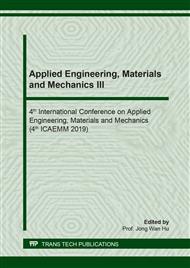[1]
W. König T. Hochschule, R. Komanduri, D. Schenectady, H. K. Tönshoff, Machining of hard materials, CIRP Annals, 33(2) (1984) 417-427.
DOI: 10.1016/s0007-8506(16)30164-0
Google Scholar
[2]
Y. Huang, Y. K. Chou, S. Y. Liang, CBN tool wear in hard turning: a survey on research progresses, Int. J. Adv. Manufact. Technol. 35(5-6) (2007) 443-453.
DOI: 10.1007/s00170-006-0737-6
Google Scholar
[3]
O. Keblouti, L. Boulanouar, M. W. Azizi, M. A. Yallese, Effects of coating material and cutting parameters on the surface roughness and cutting forces in dry turning of AISI 52100 steel, Struct. Eng. Mech. 61(4) (2017) 519-526.
DOI: 10.12989/sem.2017.61.4.519
Google Scholar
[4]
I. Maňková et al. Modelling and Analysis of Relationship between Cutting Parameters Surface Roughness and Cutting Forces Using Response Surface Methodology when Hard Turning with Coated Ceramic Inserts, Key Eng. Mater. 686 (2016) 19-26.
DOI: 10.4028/www.scientific.net/kem.686.19
Google Scholar
[5]
M. W. Azizi, S. Belhadi, M. A. Yallese, A. Lagred, A. Bouziane, L. Boulanouar, Study of the machinability of Hardened 100Cr6 Bearing Steel with TiN Coated Ceramic Inserts, Third International Conference on Energy, Materials, Applied Energetics and Pollution (ICEMAEP2016), Constantine, Algeria.
Google Scholar
[6]
K. Bouacha, M. A. Yallese, T. Mabrouki, J-F Rigal, Statistical analysis of surface roughness and cutting forces using response surface methodology in hard turning of AISI 52100 bearing steel with CBN tool, Int. J. Refract. Metals Hard Mater. 28(3) (2010) 349-361.
DOI: 10.1016/j.ijrmhm.2009.11.011
Google Scholar
[7]
A. H. Suhail, N. Ismail, S. V. Wong, N. A. Abdul Jalil, Workpiece Surface Temperature for In-process surface roughness prediction using Response Surface methodology, J. Appl. Sci. 11(2) (2011) 308-315.
DOI: 10.3923/jas.2011.308.315
Google Scholar
[8]
B. R. Sankar, P. Umamaheswarrao, V. Srinivasulu, G. K. Chowdari, Optimization of Milling Process on Jute Polyester Composite using Taguchi based Grey Relational Analysis coupled with Principle Component Analysis, Mater. Today Proceed. 2 (2015) 2522-2531.
DOI: 10.1016/j.matpr.2015.07.197
Google Scholar
[9]
P. Umamaheswarrao, D. Ranga Raju, KNS Suman, B. R. Sankar, Multi objective optimization of Process parameters for hard turning of AISI 52100 steel using Hybrid GRA-PCA, Procedia Comput. Sci. 133 (2018) 703-710.
DOI: 10.1016/j.procs.2018.07.129
Google Scholar
[10]
M. K. Pradhan, Estimating the effect of process parameters on MRR, TWR and radial overcut of EDMed AISI D2 tool steel by RSM and GRA coupled with PCA, Int. J. Adv. Manufact. Technol. 68(1-4) (2013) 591-605.
DOI: 10.1007/s00170-013-4780-9
Google Scholar
[11]
K. Pearson, On lines and planes of closest fit RO systems of points in space, The London, Edinburgh, and Dublin Philosophical Magazine J. Sci. 2 (1901) 559-572.
DOI: 10.1080/14786440109462720
Google Scholar
[12]
H. Hotelling, Analysis of a complex of statistical variables into principal components, J. Educational Psychol. 24(6) (1993) 417-441.
Google Scholar
[13]
R. Suresh, S. Basavarajappa, V. N. Gaitonde, G. L. Samuel, J. Paulo Davim, State-of-the-art research in machinability of hardened steels, Proc Inst Mech Eng B J Eng Manuf. 227 (2) (2013) 191-209.
DOI: 10.1177/0954405412464589
Google Scholar
[14]
L. Qian, M. R. Hossan, Effect on cutting force in turning hardened tool steels with cubic boron nitride inserts. J Mater Process Tech. 191(1-3) (2007) 274–278.
DOI: 10.1016/j.jmatprotec.2007.03.022
Google Scholar
[15]
Suha K. Shihab, Z. A. Khan, Aas Mohammad, A.N. Siddiquee, Investigations on the Effect of CNC Dry Hard Turning Process Parameters on Surface Integrity: A Multi-performance Characteristics Optimization, J. Manuf. Sci. Prod. 14(1) (2014) 23-30.
DOI: 10.1515/jmsp-2013-0019
Google Scholar


